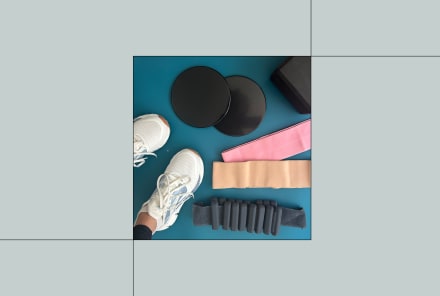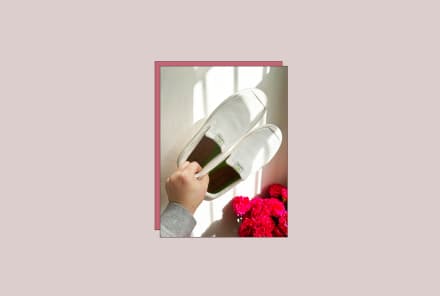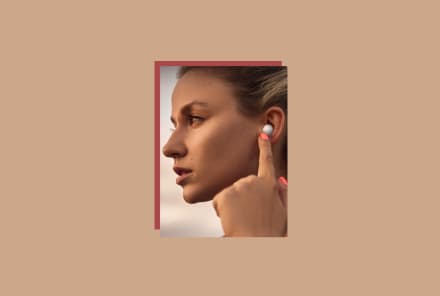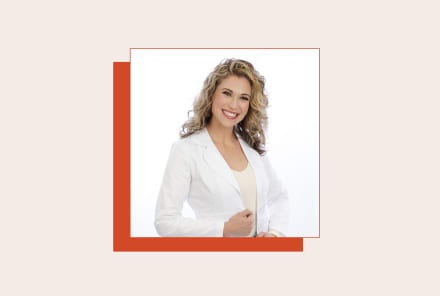Advertisement
Want To Spice Up Your Squat Game? Try Any Of These 12 Variations

Squats are a powerful move to target your lower body, and specifically the glutes and quads. But we get it—doing the same old type of squats every day can get a little monotonous. That's where squat variations can come into play.
Why do different types of squats?
Different squat variations can target different muscles, incorporate cardio, and ultimately keep things interesting. As fitness instructor Mindy Lai tells mbg, they all fall under the squat category because they work the same large muscle group but work slightly different parts of the muscles. For example, a wide squat will work your hips' rotation muscles more than a normal squat.
Here, we've rounded up 12 versions that suit different fitness goals and needs, to get you started.
Standard squat
- Start in a standing position. Bring your feet out wider than hip-distance apart. Toes turn out to 1 and 11 on a clock.
- Lower down, keeping knees over heels. Reach your butt back, and flip your tailbone toward the sky.
- Drag your shoulder blades down your back. Separate the knees from each other, don't let them knock in, and activate the outer glutes.
- Engage glutes to lift back up to start. That's one rep. Repeat for 2 minutes.
Benefits:
- Strengthens the glutes
- Strengthens the thighs and hamstrings
- Targets the hip flexors
- Works your core
Wide squat
- Stand with your feet wider than hip-width apart, and turn your toes out to 10 and 2 on a clock.
- Bend your knees, lower down halfway, and freeze. Knees should stack right over heels, and heels press into the ground. Tailbone is heavy. Keep shoulders and hips in the same line. Pull your waist in; drop your shoulders.
- From here, sink as low as you can. If your knees start to pop in, actively press them toward the wall behind you. Feel the outer glutes engage.
- Bring your arms out to the sides. Drop your shoulder blades down your back, pull the waist in, drop the collarbone, and sit a little lower.
- Continue lifting and lowering for 3 minutes while including movement variations with your arms.
Benefits:
- Great for strengthening the hip joint
- Works the inner thighs more than a regular squat
- Targets quads and core
Split squats
- Start in a standing position, then step your left leg behind you. This is your starting position.
- Hinge slightly at your hips, bend your knees, and lower down. Keep your back heel up and your front heel down. Engage your glutes and quads to come back up to start.
- That's one rep. Complete 10, then repeat on the right side.
Benefits:
- Works your glutes, quads, and hamstrings
- It works your body unilaterally (one side at a time), which helps build both sides equally
- Works your balance
- Strengthens the hip flexors and knee joints
Learn more about split squats here.
Jump squat
- Start in your squat position.
- At the bottom of the squat, squeeze your glutes, press into your heels, then roll through your feet and propel upward off your toes.
- Land softly on your feet, then use the momentum from landing to move into your next squat. That's one rep.
Benefits:
- Powers up your lower body, including glutes and thighs
- Adds a cardio component to your normal squat
- Pushing off the ground works the legs more than a regular squat
- Improves agility and coordination
Learn more about jump squats here.
Jump squat with heel clicks
- Start in a narrow squat position (toes at 11 and 1 on an imaginary clock, knees over heels, tailbone back, core engaged, and shoulders soft).
- At the bottom of the squat, squeeze your glutes, press into your heels, then roll through your feet and propel upward off your toes. At the top of your jump, click your heels together in midair.
- Land softly on your feet, then use the momentum from landing to move into your next squat. That's one rep.
Benefits:
- Strengthens the quads and glutes
- Works the inner thighs
- Adds a cardio component to your strength training
- Improves agility and coordination
Learn more about jump squat with heel click here.
Curtsy lunge to squat
- Start in a standing position. Bring your feet out wider than hip-distance apart, with toes pointed at 11 and 1.
- Lift one knee up next to your body, then cross that leg behind your opposite leg.
- Press your back toes into the ground, and bend your knees. Send your hips back, tailbone up, waist in, and shoulders down.
- Lift your back knee back up, place your foot back down into a squat position, then lower down into a squat.
- At the top of your squat, lift the opposite knee up and repeat on the other side. That's one rep.
Benefits:
- Combines benefits of lunges and squats
- Fires up quads, hamstrings, and glutes
- Works your balance and coordination
- Adds cardio component to strength training
Squat to curtsy lunge to tree pose
- Start in a standing position. Bring your feet out wider than hip-distance apart, with toes pointed at 11 and 1. Slowly lower into a squat and return to start.
- Step one foot back, crossing that leg behind your opposite leg, and bend both knees slightly.
- Step back to your narrow squat. Send your hips back, tailbone up, waist in, and shoulders down.
- With that same foot that crossed, rebound up to a modified tree pose—balancing on one leg, with the other foot pressed above or below your standing knee (just not on your knee).
- Land softly on the ground, and bend your knees to find your narrow squat again. Repeat on the other side. That's one rep.
Benefits:
- Tests your balance and coordination
- Works inner thighs and hip flexors
- Works glutes, quads, and hamstrings
- Offers cardio component
Malasana squat
- From a standing position, lift your arms up to the sky, then bend forward, bringing your hands to the ground.
- Walk your feet hips-distance apart.
- Bend your knees, pivot your toes out, and slowly lower into a squat. Hold for a couple of breaths.
Benefits:
- Stretches the thighs, hips, and groin
- Increases circulation to the pelvis
- Works balance and concentration
- Works the core
Bulgarian split squat
- Hold a weight in your left hand, and stand next to a chair. Lift your left leg onto the chair, pivot so you're facing away from it, then rest the top of your left foot on the chair.
- Sit your hips back and down, with a slight hinge, and lower down until your left knee is pointing toward the ground. Drive through your right heel to press back up to start.
- Complete 10 reps, then switch to the other side.
Benefits:
- Work your quads and glutes
- Strengthens the hip flexors and knee joints
- Unilateral (one-sided) movement works each leg deeper, one at a time
- Works your balance
Squat to toe touch
- Start in a standing position, with your feet hips-distance apart and hands behind your head.
- Hinge at your hips, bend your knees, and drop your body down until your thighs are parallel with the ground.
- As you come back up to start, kick your left foot into the air, and touch your toes with your left hand. Lower back down and repeat on the right side.
- Continue for 1 minute.
Benefits:
- Works the hip flexors and knee joints
- Requires balance and stability
- Works the glutes, quads, and hamstrings
- Targets the core
Pop squat
- Start in a standing position.
- Jump your feet out wide, and simultaneously reach down and touch the ground with your right hand.
- Hop your feet back together, then repeat with the opposite hand.
- Continue for 45 seconds to a minute.
Benefits:
- Adds a cardio component to strength training
- Strengthens entire lower body, including glutes, thighs, hips, and calves
- Works flexibility in the hips and knees
Squat to heel lift
- Start standing, with your feet shoulder-width apart. Heels are slightly turned in.
- Slowly sit your tailbone back and down, sinking weight into the heels, lowering into a squat.
- Press through your heels, and squeeze the glutes as you stand up.
- Then, lift your heels up, coming onto your toes.
- That's one full round. Continue for 1 minute.
Benefits:
- Strengthens the hip, knee, and ankle joints
- Works the calves, as well as the quads, glutes, and hamstrings
- Works your balance and coordination
- Stretches the hips
Watch Next
Enjoy some of our favorite clips from classes
Enjoy some of our favorite clips from classes
What Is Meditation?
Mindfulness/Spirituality | Light Watkins
Box Breathing
Mindfulness/Spirituality | Gwen Dittmar
What Breathwork Can Address
Mindfulness/Spirituality | Gwen Dittmar
The 8 Limbs of Yoga - What is Asana?
Yoga | Caley Alyssa
Two Standing Postures to Open Up Tight Hips
Yoga | Caley Alyssa
How Plants Can Optimize Athletic Performance
Nutrition | Rich Roll
What to Eat Before a Workout
Nutrition | Rich Roll
How Ayurveda Helps Us Navigate Modern Life
Nutrition | Sahara Rose
Messages About Love & Relationships
Love & Relationships | Esther Perel
Love Languages
Love & Relationships | Esther Perel











